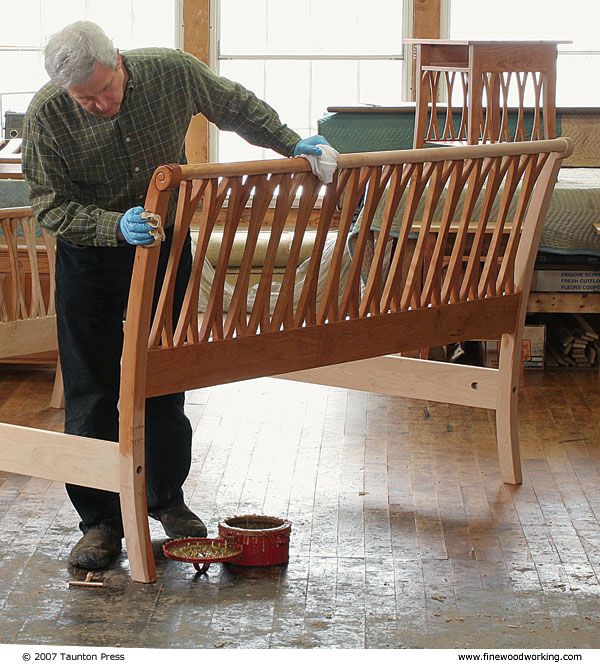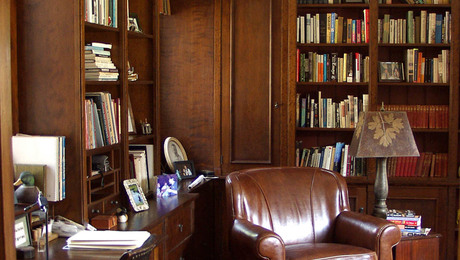
Custom furniture makers: How do you explain your pricing to skeptical clients?
To the uninitiated, a custom piece of furniture can seem ridiculously expensive—especially when compared to “fine furniture” retail counterparts like Ethan Allen or Bassett Furniture.
I’m sure that you folks out there have run into sticker shock when talking to clients about pricing. How do you educate your clients to explain why your work can cost so more but is also worth more?
This exact question came up at a dinner party this weekend. Some friends were looking at some custom work but were skeptical at the cost of a dining set and worried they were getting fleeced. I’m not a pro and I’m just a beginning woodworker, but below are some ways I tried to explain the price differential. Was I on target? What other points do you raise when talking to clients?
-Solid-wood lumber is really expensive… the materials alone for a project cost a lot. Many large furniture companies cut orders using MDF, plywood, and inexpensive hardwoods.
-You’re getting one of a kind custom work. A one-man-shop can’t find the same economies of scale that a retailer can by mass producing work on assembly lines.
-It’s an heirloom. You’re buying hand-crafted work that you can pass down through generations.
-It’s art. When you buy custom work, it’s more akin to buying a piece of art than something just to sit on. When you buy a person’s work you’re buying into their name and prestige too. That’s why seasoned woodworkers can often charge more than someone just starting out.
-Many undervalue their work. I don’t know much about this, but I’ve heard that new woodworkers often sell their work for less just to get started. For a new buyer, they may not be able to tell the difference between a seasoned and a newbie furniture maker making the seasoned furniture maker’s work seem overpriced.
-The definition of fine furniture. With manufactured furniture all around us, most buyer’s definition of “fine” is probably very different than the visitors to this site where we judge craftspeople by their taste, skill, and use of traditional joinery techniques.
Anyway, that’s how I tried to explain it all. We also looked up pricing on some known woodworker site as a comparaison like Christian Becksvoort, Jeff Miller, and even Thos. Moser.
How do you folks explain this to your clients since I’m sure you’ve had this conversation over and over again.


















Comments
The question you ask is the big one. Sometimes I think it's the only one that matters. Everything you write is true - I know a few guys who'll launch their standard "I-can't-compete with-China" speech at a moment's notice (I'm one of them!).
In my experience, most clients can be lumped into one of two groups: People looking for one-of-a-kind, heirloom quality furniture, and people looking for a very small modification to an existing furniture store piece. I'm sorry to say that the latter category is (in my experience) by far the larger. And for those people, everything you, and I, and Custommade.com, and the whole universe of craftspeople say on the subject of quality doesn't matter that much. For them, we are simply the custom department of Ikea, or Ethan Allen. Their quality is good enough for what these people need. And they don't want to spend $4k on a spectacular handmade bookcase, when the one in the furniture store would work, if only it was 3" narrower.
I'm not finding fault with those people at all. It's just that trying to use our stock arguments on them is of little use - after all, I must begrudgingly admit that a Haverty's bookcase will actually hold books off the floor.
I have tried the "spend-$4k-now-instead-of-spending-$500-ten-times" speech. But it mostly fails because even in the cases where my arguments are accepted as valid, $500 is a lot easier to come up with than $4000.
The answer is very simple “perceived value” which in turn is affected by how educated one is about the subject. The problem is in the education of the client. We are so programed by the big box marketing that the value of quality has been diminished in our thinking.
Don B.
Agreed! From what we hear from our subscribers and our woodworker friends, this is one of the toughest parts of having a successful woodworking business. If the client expects to pay brand name prices for handmade goods, the price tag will often shock the client or could even break the deal because the client has little to no understanding concerning what they are actually paying for. A huge part of marketing any woodworking business is educating the customer and explaining why handmade goods are an investment rather than simply a purchase.
Hi Gina,
I'd expand on some of your very good points and add others:
--Solid wood being expensive is part of the case. But a custom maker ideally chooses each individual piece of wood very carefully for color and grain. This results in a piece with far greater harmony and beauty than a factory made piece. On the other hand, veneer (even veneer-core plywood) does not imply an inferior material choice. That type of education process is difficult and tiresome after a while.
--"One-of-a-kind" only matters if it is that and if it is an impressive version of that, and if the prospective client gives a hoot. In my work, meeting critical functional requirements (as opposed to ornamentation or fine workmanship) constitutes a version of one-of-a-kind value for my customers.
Heirloom, Schmeirloom! That's a hard sell. When does something get heirloom status? Only after it's been handed down a generation or more. You can't designate a new piece of furniture a future heirloom.
It's art? I've always had a problem with furniture as art. Artistic? Sure. Artisanal? Let's hope so. But if you call a chair a work of art, aint nobody gonna be comfortable sitting on it. Furniture has to serve a specific function first, and anything artsy or otherwise that detracts from that function diminishes the piece. Exceptions abound of course. Sculptural furniture can be both solid as furniture and beautiful as art. Just not at the same time, perhaps?
Newbie vs. pro pricing--that's a good point. The first commission I did was while working for a larger company that allowed me to use the shop for side work. So I made a bed for a young architect with zero overhead--didn't pay for the rent or the tools or even the electricity to use the tools. I only needed to charge for my time, and as a newbie it was ridiculously low. Them were the days. While it was a win-win deal for me and the architect, other independent woodworkers would rightly claim this scenario drives down the fair market value of custom work. On the other hand, many fine custom furniture pieces would never get made if priced "fairly" because those buyers would simply do without or go to Kmart or Ikea. And now? I'll work for less than my desired rate in order to pay the shop rent and my house mortgage and my daughter's college tuition. It's simply the lesser of two difficult paths. (I've tried both.) Lastly, Being custom made doesn't assure that something is well-made. In the US, there are zero barriers to setting up a garage shop and selling work of dubious quality.
--As Don B said above, perceived value is really the key issue. Though I love to make furniture, my core business is custom built-in cabinetry. All my customers find a high perceived value in what I'm providing, partly due to its unique function and partly to the value it can add to the home. Fortunately, there's no retail competition for truly custom built-in cabinetry, just other makers like me. Totally different for furniture. I've built $10,000 wall units for folks who would recoil at spending more than $500 for a sofa table, no matter how finely it was made. It's strange, because chances are moderate that my built-in work will get torn out during a remodel in 20 or 30 years by a new owner, while a good piece of furniture really will last many more decades.
--An appreciation of quality begets an appreciation of quality, so it behooves us to do our best work, even when the money is less than ideal.
Tony O'Malley
http://www.tonycustomwood.com
I am rather skeptical of the original premise: Is there anyone who is able to even consider the possibility of purchasing a custom-built dining set (in the tens of thousands of dollars, at least) who also worries that they may be getting fleeced?
The people who are shocked by the price of custom furniture are equally shocked by the price of off-the-shelf high-end furniture, because the two sets of prices really aren't that far apart. I just looked over at the DWR web site, where I see that (on the low end) I can buy a George Nakashima-designed dining chair for $634, or (on the high end) a Frank Gehry-designed dining chair for $2605. Both 100% off-the-shelf. I found a similar range of prices at the Thomas Moser site.
Now, Sam Maloof could sell a rocker for $25,000, and Michael Fortune can sell a custom-built dining chair for $11,000, but I think most of us thinking to get into the business would be perfectly happy to sell custom-designed chairs in the $1000-2000 range, at least while starting out. And if that's a hard sell, all we have to do is point to off-the-shelf retailers like the ones mentioned above to show that we're not fleecing anyone (at least not any more than established businesses are).
I'm generally in agreement with tonyowood regarding the other points. "Solid wood" may be a buzzword selling point at the low end, but if you're making custom furniture for sale and setting prices based on the cost of the lumber, you're Doing It Wrong. Likewise, the "heirloom" argument is at best arrogant. I don't have much interest in creating art for art's sake. For me, it's more of a compliment for someone to say that a chair I made is comfortable than to say that it's a work of art.
I'm not really sure that "fine" is a valid differentiator, either. I can buy a Navy side chair from DWR for $350. It's comfortable, well-made, and all but indestructable. How is that not "fine"? (It's also priced at a point where I'd barely cover the cost of materials if I were to try to make something equivalent in wood.)
-Steve
The newbie thing is an important issue. Until you have proven yourself it will be more difficult to convince someone of the value of your work. Once you have developed a reputation for quality and reliability it's seldom necessary to explain higher prices, at least that was my experience. Since most of my work was based on word of mouth, most prospective customers came in with the idea that I charged more than comparable woodworkers.
Besides reputation, presentation is also important. I don't mean explaining why your price is higher. I believe those explanations may well put people off. Instead, express the quality of your work and your passion for it. Even though your prospective customer may not understand what you're explaining, they will appreciate that you taking the time to provide such detail. On more than one occasion I learned, after completing a project, that my price was considerably higher than other reputable woodworkers whom he had called for pricing. When questioned about it the answers always referred to my presentation. I've never been much of a salesperson so I'm certain it wasn't my sales ability but I've always enjoyed explaining my work and I guess they appreciated the time I took with that.
Bill
I try to educate the client on my pricing immediately. I point them to my web site or to a gallery who deals my work. The points Gina made are good ones but most become self-evident after the client sees current and past work. I don't give my clients the hard sell by pointing out all the pluses of a custom made piece. They can't get ikea or target to come to their house and make a piece just the right size to fit between the fireplace and chair and just the right shade of brown to go with the painting on the wall. That is what they are paying for.
Thanks for the feedback, thought-provoking insight on the state of the marketplace.
And re: my art comment, I guess I was thinking about it in terms of studio furniture makers and makers who specialize in more "decorative" works like Tom Schrunk. Good point that not all furniture or makers really fit in that category.
In case you haven't seen it, Chris Becksvoort has a nice explanation on his site about what sets his work apart:
http://www.chbecksvoort.com/tbeckdiff.html
Anyone out there have a similar explaination on their site or in pamphlets that they hand out to really spells out some of the points that we're talking about here?
Just curious... -Gina
Wow, this is a subject that crosses pates with me almost daily!
I also have tried the spend $4000 now instead of $500 five times or different variations of the same explanation. I have also explained that I’m not IKEA and I don’t compete with them.
I just love it when I meet with a perspective client and they pull out a catalog and ask “can you make XYZ, but it must fit in this space”
I usually write up a quote knowing that I won’t get the work, but hoping that eventually if they need something special they’ll remember me as being punctual and personable and call me.
I found the best avenue for business is through the contractors I have worked with. I retain their cards and when the situation is called for I return the favor by recommending them to potential clients.
As for explaining price to clients I was stumped by a customer whom asked me why he should pay me more for a piece of furniture when he can go buy one “off the shelf” and “ready made”.
I tried to explain that I can customize a design to fit his particular needs rather than trying to fit a store bought item into a space not suited for it.
He couldn’t even begin to understand why this means the item costs more! I didn’t bother myself further, but now that I think back to that incident (last year) and I feel this could have been good training for me. Perhaps it already was?
I.E. don’t waste your time on these people, they aren’t your clients.
Chaim
Not having to rely on making furniture for may income, I may not be considered justified in making a comment here, but I will because I have made and sold cabinets and furniture.
First, if someone is considering something like the things sold at Ikea or Pottery Barn, then I tell them they should get them there. When I look at top of the line furniture like Stickley or Baker or such, I don't know if I could do a better job at any price. Much of this stuff is very well made (at least before they started making it in China and VietNam) and they have it pretty well perfected. The only reason I could figure out for someone to want what I make is if I make something that they can't buy from a high end furniture or cabinet company. Then I can shine. For instance, a person was recommended to me. He asked me if I could make some cabinets for a bar in the french provencial style with glass panels and glass shelves and mirrors in the back, and would not be wider than 17inches. I told him sure, drew up the plans, submitted them and had him sign off, and built the cabinets. When I finished, he was so happy, he tipped me $300.00. On the other hand, when people have asked me to make kitchen cabinets for them, I generally tell them to buy the premade unless they want something they can't buy premade.
The same with furniture. I made a serpentine front chest of drawers from solid Honduran Mahogany and it came out real nice. Can I say it is better than the ones made by Stickley? I don't think I can. On the other hand, I made a circular table, 52inches in diameter, with a karilian birch veneer top. The top and base were of my design. When I sold it, I knew that the only place that my customer could get one was from me. I made 6 lyre backed chairs to go with it.
My point is, the work should speak for itself. You shouldn't have to be a salesman.
On the other hand, I haven't sold that much and I don't make that much. But I believe that is why guys like Sam Maloof were so successful. He made a product that was his own and like nothing else. He didn't do Ikea.
Greater exposure is need to make the general public aware of what we do. A reality show about a custom furniture maker and his dysfunctional family/employees, something on the lines of the 'American Chopper' and 'Pawn Stars' series. Fine Woodworking and Custom Made could sponsor it.
Don B.
This is all great feedback, It seems to me like some of you try to be upfront about price and almost "pre-qualify" clients before spending much time discussing the project as to not waste your time. Don, thats a great idea! Maybe we can make something like that happen in the future.
Most of my clients are established professionals with a certain amount of disposable income. I don't think they question much what they pay for their cars, boats, or the art on their walls. They pay for the services of architects, interior designers, and private chefs, and I want to be perceived as being in the same category. I let them know up front what I think the approximate costs will be, and I am very matter of fact about being a professional who will provide them with a high level of professional service. I show them a large portfolio of my work. I carefully listen to them. I provide scale drawings before beginning any project. By my approach, I think they understand they are paying for a level of personal service and not just a product.
Also, for me it is about creating something the client will be somewhere between very happy and ecstatic about. Since I make furniture for a living it is vital that they respond to what I do. Many furniture makers coming out of university programs and design schools do original, high level work but it looks like it is more about self expression or impressing teachers and peers. 99.9% of people on the planet don't understand it, and even those that can afford, don't want it. Each one of us who does this professionally has to ask ourselves what it is we are trying to do. I want to do original, high level work, but I also want it to be accessible and liked by many. If I do things that enough people emotionally respond to, the work, along with the service, will sell itself.
In my opinion it's also important to identify the difference between truly Custom (from the ground up) and Made to Order. A lot of my clients come to me asking to copy the picture in the catalog of brand X, "but make it longer and not out of Red Oak." OK, I can do that. But that's not really "custom." That to me is made to order with modifications. Some say that they have no idea what they really want, but they really like "these" pictures, and then hand you a pile of 150 pages ripped out of magazines. Well, I can do that too. This is custom. Explaining the difference is important. Personally for me, I am happy to modify a cabinet that is made from brand X in order to fit my clients needs. And yes, the cost of that product is significantly more than the catalog, however much less expensive than the piece I have to design from the ground up.
Clear and simple communication with the correct buyers is critical for me. Clearly explaining perceived value is KEY. That is done on a case by case/client by client basis. Sadly, what we do as "craftsmen" or "artists" takes a backseat to our abilities as marketers and salesmen.
Interesting and very educational....i am at the point in my career where marketing is like hand planing curly maple.
Cheers.
Log in or create an account to post a comment.
Sign up Log in